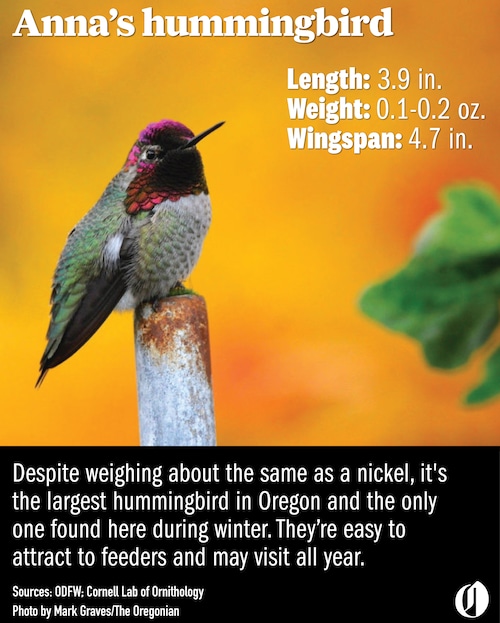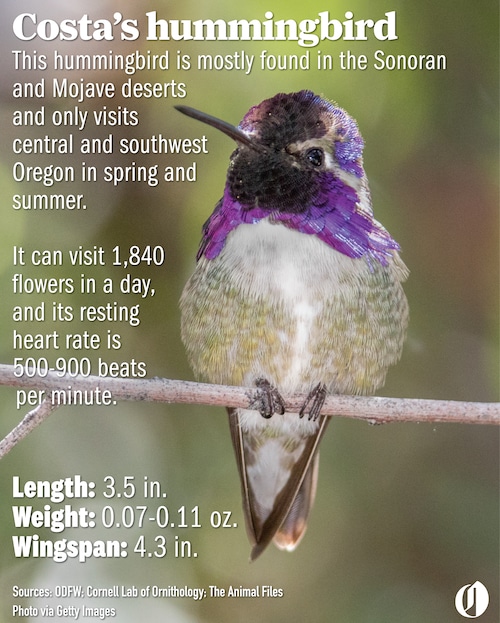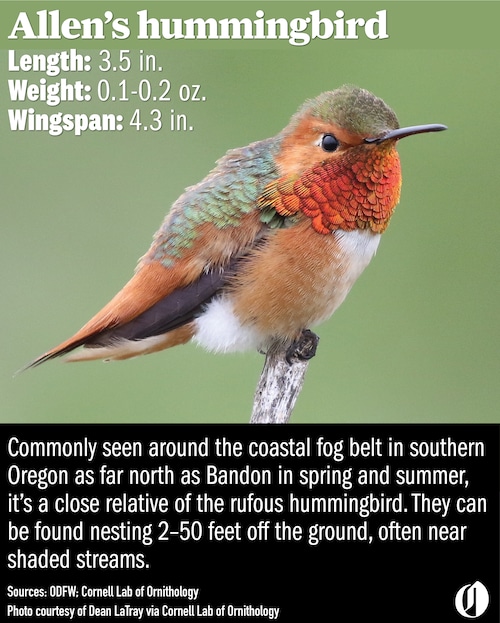Of over 300 hummingbirds species, which are only found in the Western Hemisphere, just seven of them can be found across Oregon. They include the black-chinned, Anna’s, Costa’s, calliope, broad-tailed, rufous and Allen’s hummingbirds.
Below are seven illustrations with photos, videos and audio detailing Oregon’s seven species.
Good to know hummingbird info:
- Most are found within just ten degrees north and south of the equator and less than two dozen species venture into the U.S. and Canada. Very few remain in the U.S. year round.
- They are the only birds that can fly backward and straight up and down, and one of the few animals that can hover.
- Their wings flap faster than any other creature with wings — up to 4,000 wing beats per minute — and their heartbeat can pump up to 1,000 times in a minute.
- Though rare, they have unusual predators including praying mantis, spiders, bees and wasps, and even frogs.
- Hummingbirds, specifically the males, are saturated in a spectrum of vibrant colors that can change radically in sunlight. According to the Audubon Society, they get their “iridescence colors from crystalline stacks of lozenge-shaped proteins in their feathers’ smallest filaments, which bend color depending on the angle of observation.”
- Hummingbirds are actually more colorful than humans can imagine. Birds can see colors humans can’t and hummingbirds are probably the most colorful birds on earth. Most avian eyes have a fourth cone that picks up ultraviolet light. Humans only have three.
- The male hummingbird’s attractive colors evolved over time as they competed against each other to appear the most dazzling to females.
- Unlike some birds, hummingbirds do not mate for life and males mate with multiple females.
Here is the list:

Mark Graves/The Oregonian

Mark Graves/The Oregonian

Mark Graves/The Oregonian

Mark Graves/The Oregonian

Mark Graves/The Oregonian

Mark Graves/The Oregonian

Commonly seen around the coastal fog belt in southern Oregon as far north as Bandon in spring and summer, it’s a close relative of the rufous hummingbird. They can be found nesting 2–50 feet off the ground, often near shaded streams.Mark Graves/The Oregonian
More oregon wildlife
- Spring Whale Watch Week: Here are Oregon’s 10 most famous gray whales to keep your eyes peeled for
- World Whale Day: Get to know 10 of Oregon’s most popular gray whales
- Endangered green sea turtle rescued at Oregon’s Manzanita Beach
- Think Wild returns rehabilitated bald eagle to central Oregon wild
- The boneless, bloodless and brainless, from 1 inch to 100+ feet long: Get to know Oregon’s jellyfish (graphics)
-Sources: ODFW; Cornell Lab of Ornithology; hummingbirdsociety.org; Audubon
–Mark Graves/The Oregonian, 503-860-3060, mgraves@oregonian.com
@Mark_W_Graves
More:
- Sharks of Oregon: The 8 largest sharks found off Oregon’s coast
- Get to know 10 of Oregon’s most famous gray whales
- Oregon wolves: 9 graphics that explore where they roam, live and die
- Owls of Oregon: Get to know the 14 species found here, from pygmy to great horned owls

